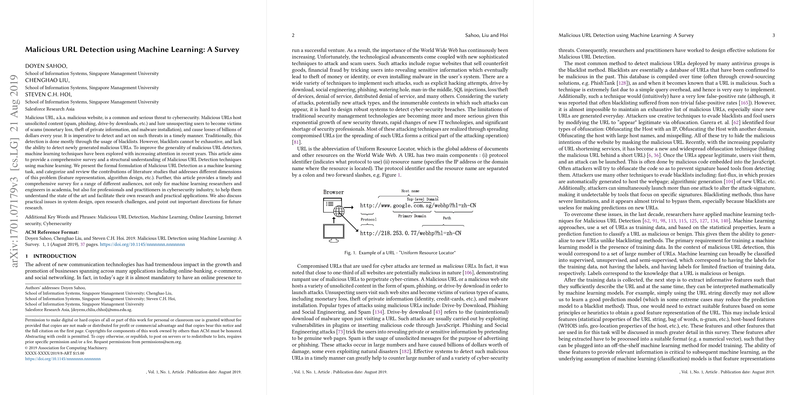Malicious URL Detection Using Machine Learning: A Survey
The paper "Malicious URL Detection using Machine Learning: A Survey" by Doyen Sahoo, Chenghao Liu, and Steven C.H. Hoi provides an extensive review of machine learning techniques employed in detecting malicious URLs. Given the consequential threats posed by malicious URLs, including phishing and malware, the research acknowledges the inadequacy of traditional methods such as blacklisting and stresses the imperative to leverage machine learning for enhancing detection efficacy.
Comprehensive Analysis of Feature Representation
Central to the task of malicious URL detection is the challenge of effective feature representation. The paper categorizes features into several distinct types:
- Blacklist Features: These are based on existing databases of known malicious URLs but are not exhaustive and require enhancement through derivations like approximate matching.
- Lexical Features: These focus on the URL string's statistical properties, including lexical pattern analysis, which has become critical especially for detecting algorithmically generated malicious URLs.
- Host-Based Features: By analyzing domain-related data, such as WHOIS information and geographic properties, these features provide contextual insights.
- Content-Based Features: These delve into webpage content, HTML structures, and JavaScript code to identify malicious activities.
- Other Features: These include context features such as the URL's presence on social media platforms and popularity metrics derived from web traffic and search engine data.
The paper comprehensively assesses the practicalities of each feature type, including collection difficulty, associated security risks, and computational overhead. This evaluation aids in understanding the trade-offs inherent in deploying these features in real-world systems.
Machine Learning Techniques for Detection
A significant portion of the paper is dedicated to discussing the machine learning methodologies suitable for classifying URLs as malicious or benign. It categorizes the learning algorithms into batch learning, online learning, representation learning, and other methodologies.
- Batch Learning: Traditional classifiers like SVM and logistics regression are discussed for their effective application in fixed datasets. The paper highlights logistic regression's adoption due to its interpretability and efficiency, especially when combined with L1 regularization for feature sparsity.
- Online Learning: As URL data is vast and continuously growing, online learning techniques, including first-order and second-order methods, are emphasized for their scalability. Confidence-Weighted learning, in particular, capitalizes on second-order statistics to enhance efficacy in high-dimensional feature spaces.
- Representation Learning: The integration of deep learning approaches, particularly the application of CNNs and LSTMs, is noted for its potential in feature representation directly from raw URL strings.
- Cost-Sensitive Learning: The importance of handling the differential costs of misclassification is addressed, suggesting the need for sophisticated algorithms that can adapt to the imbalanced nature of URL datasets.
Practical Implementations and Future Challenges
The implementation of malicious URL detection systems as a scalable service is discussed with an emphasis on the design principles of accuracy, detection speed, scalability, adaptation, and flexibility. Examples from real-world systems like Monarch and WarningBird showcase practical applications, although the paper notes that significant challenges remain in fulfilling these goals effectively.
Finally, the paper outlines several open challenges, such as dealing with high-dimensional feature spaces, managing concept drift, and achieving interpretability in model predictions. The emergence of deep learning is acknowledged as a promising avenue, yet it is subjected to computational limitations that need addressing for real-time applications.
In conclusion, while machine learning has decidedly advanced the field of malicious URL detection, the paper identifies numerous opportunities for further exploration, particularly in integrating novel learning paradigms and addressing adversarial threats. As such, this survey serves as a cornerstone for researchers and practitioners aiming to develop more robust and comprehensive cybersecurity defenses.
